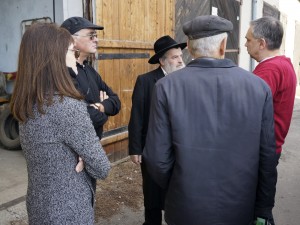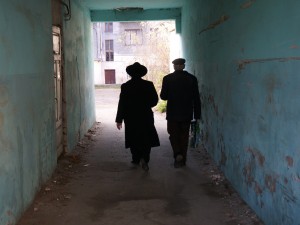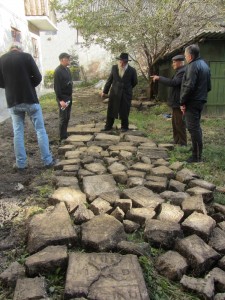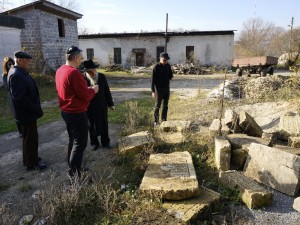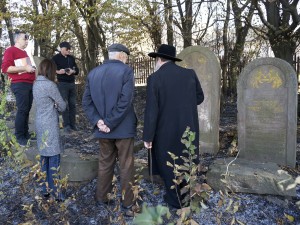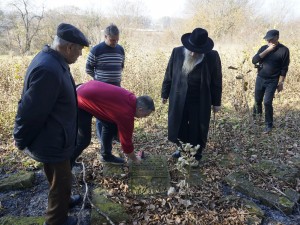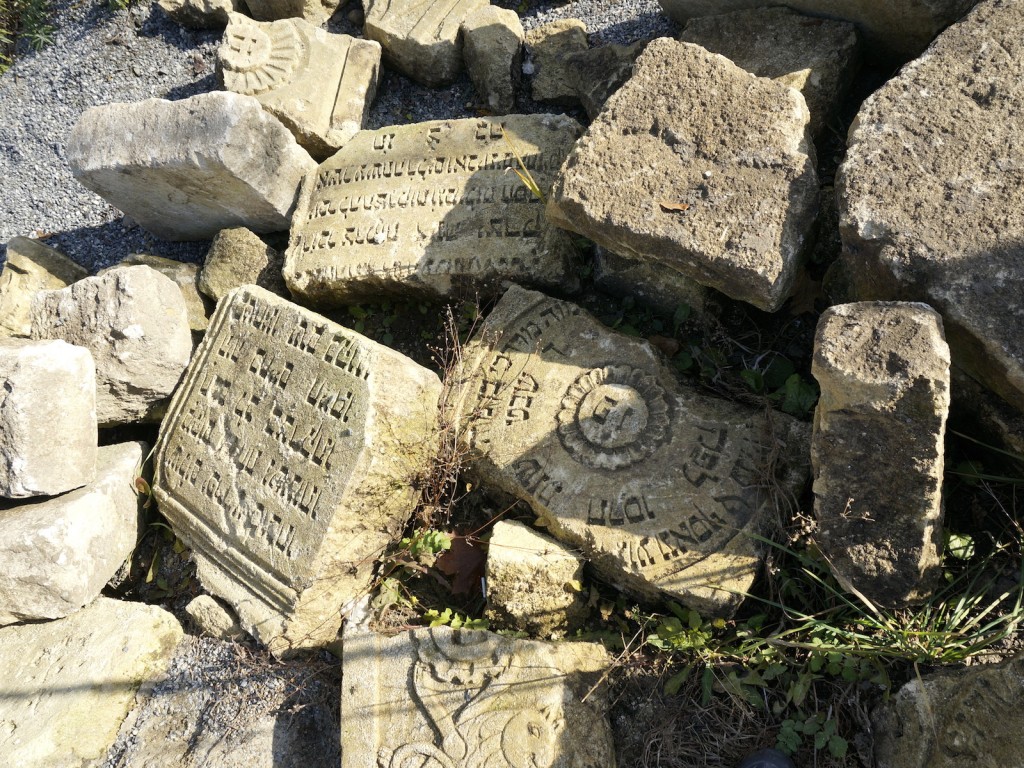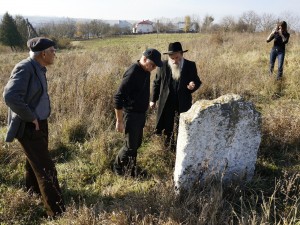Marla and I visited Rohatyn yesterday (06 November 2014) with several others, to check status of the Jewish headstone recovery work and to meet onsite for planning regarding the proposed Jewish cemetery project. The group consisted of:
- Marla Raucher Osborn, project lead
- Alex Denysenko, guide & translator
- Andrij Bojarov, conceptual design lead
- Rabbi Moyshe-Leib Kolesnik of the Ivano-Frankivsk synagogue
- Mikhailo Vorobets, Rohatyn town historian and local volunteer manager for headstone recovery
- Jay Osborn, project planning & communication
Rabbi Kolesnik is responsible in the Ivano-Frankivsk region and has acted on the group’s behalf in Rohatyn in the past. He was invited to join us yesterday specifically to discuss issues in the Rohatyn old Jewish cemetery, but we had the pleasure of his company for the entire day. We were driven from and to Lviv and assisted in the cemeteries and around town by Alex’s driver Vitaly.
![]() Ця стаття також доступна українською.
Ця стаття також доступна українською.
Marla has reported separately on the memorial plans for the human remains found under the Ukrainian church in town.
Headstone Recovery Project:
Since the last report (29 July 2014), a significant number of new headstone pieces have been uncovered. Mr. Vorobets brought us back to the courtyard/parking area off of vul. A. Mitskevycha (commonly linked to former Gestapo headquarters building there) where many headstone pieces have been found in the past few years. Last week he directed the excavation of soil at the northern edge of the parking area, where about 80 small- and medium-sized carved stones were uncovered and set aside, along with many more small fragments.
Mr. Vorobets reported that the stones were about 0.25m below the soil surface. This area is around a building corner from the residential garden which yielded many large headstones in several prior excavations, and about 50m from the utility building foundation which has yielded more than a dozen headstone pieces in past years.
Rabbi Kolesnik read aloud the inscriptions visible on many of the stones and determined that all of the pieces came from stones stolen from the old Jewish cemetery south of town, mostly from 19th-century burials. Walking out of the courtyard, the Rabbi began the same hunt for lost headstones that has captured all of us who have visited the town, scrutinizing the utility building foundation and other building footings; we should not have been surprised when he turned over a headstone piece previously unrecognized, at a far edge of the parking area (Mr. Vorobets recorded that stone for transport also).
Next we visited the site of the northern mass grave memorial, behind the construction materials yard. After leading a prayer at the mass grave, Rabbi Kolesnik reviewed the pile of recovered headstones there (see the July status report). Here again, he concluded that all these stones were taken from the old Jewish cemetery, the stones dating from about 1850 to 1905. The group spent some time comparing stone pieces, looking for matching parts, and admiring the carving on many of these large sections.
We then visited the new Jewish cemetery north of town. Surveying the land there, the Rabbi said from his experience that he suspects there may be an unmarked grave of many shooting victims in the front/lower portion of the cemetery (Marla and I are not aware of any historical events of this type at the cemeteries, but if anyone else is aware please feel free to comment).
We looked at the condition of the several groups of stones there: standing and toppled granite stones at the east edge of the cemetery, soft stone pieces gathered in the 1990s at the eastern edge, and the many soft stone fragments our group has collected around the central memorial. Based on material and design and some dates, the Rabbi believes all of the recovered stone pieces were from graves in the old Jewish cemetery, i.e. only the few surviving granite stones still in the new cemetery originate in the new cemetery; he also believes that a single granite headstone lying in a shrub toward the western edge of the cemetery is not over its grave, and belongs with the others at the eastern edge.
Rabbi Kolesnik then advised that all of the headstone pieces recovered to date should be returned to the old cemetery; the stones excavated this year and not yet in a cemetery should be moved first, and those recovered pieces we and others have collected in the new cemetery should be moved to the old cemetery when the project there is ready to receive them (the Rabbi said that any stones now in a cemetery are safe, so need not be moved until we are ready). Mr. Vorobets will move the recent stones to the lower plain of the old Jewish cemetery, which is accessible by truck and cart. All future recovered stones will be placed there also.
I will send Dr. Feller a set of images of the newly-recovered headstone pieces, and an accounting of the headstone recovery project expenses to date, in the next few days. Mr. Vorobets still has a little over 3000UAH in funds available for digging and transportation labor costs.
Cemetery Memorial Project:
Mr. Bojarov invited Rabbi Kolesnik to review the conceptual plans for the cemetery project, and to advise us about several potential issues/risks associated with the landscaping and construction of the memorial features. Mr. Bojarov has experience in design and construction of art/architecture projects in public spaces; since our last visit to Rohatyn together, he joined the program management of the large Lviv Central Synagogue Square project, and has helped achieve a key design agreement between project stakeholders.
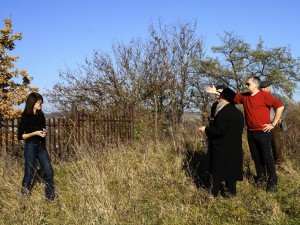
Discussing concepts for suitable placement of headstone fragments at Rohatyn’s old Jewish cemetery. Photo © 2014 Jay Osborn.
At Rohatyn’s old Jewish cemetery, Mr. Bojarov and Rabbi Kolesnik discussed the proposed concept and the likely site work, walking the site as they talked so the Rabbi could visualize the work and the results. The Rabbi approved the concept and provided information and suggestions to help the planning of the features and the work. Specifically:
- a location for the hard features was agreed, aligned with the high northern edge of the cemetery and starting approximately 50m below the east edge; Rabbi Kolesnik agrees that this location, with beautiful views over the town, is an ideal location for contemplation
- the Rabbi believes it is unlikely that there are graves within about 2.5m of the northern fence, except possibly high in the cemetery near the east edge (this helps to set the proposed location for the project’s hard features)
- and that the earliest graves in the cemetery should be about 1.8~2m below the soil surface, the latest burials perhaps 1.0m minimum depth
- and at any rate it is unlikely that any graves will be disturbed by landscaping or digging for hard features to a depth of 30~40cm
- Rabbi Kolesnik advised that if bones are discovered during any project digging, it is acceptable to either re-cover them and leave them in place (moving project features around them) or to move the bones to another location nearby, re-burying them carefully and respectfully
- to further minimize disturbance, Mr. Bojarov proposes to investigate whether it will be possible to borrow an echolocation rig to more carefully survey the subsoil in advance of physical work in the cemetery; a rig has been used in the Lviv area recently and may be available for this
- ideas on materials for landscaping and hard features were discussed; the Rabbi expressed his preference for a simple design which relates the scale of the site and the view to the memorial and the stones, and that visitors should be able to interact with the stones visually and by touch
All of these points will be included in the written project plan, with sketches and dimensions; I will provide the group with key drafts as the proposals and plans develop. Marla and I are meeting with Mr. Bojarov again on Monday to incorporate Rabbi Kolesnik’s advice into the overall plans.
Overall it was a very productive day for both projects, with good support and good decisions to help move things forward. Several photos of the day from Marla’s and my cameras are attached here; Dr. Feller will add the latest headstone images to the group site collection soon, and Marla will post more and larger pictures than the Google site allows on facebook.
Thank you to all who joined us in town yesterday, and everyone who was there with us in spirit.
[Note: This report was originally sent by Jay to the Rohatyn District Research Group.]

